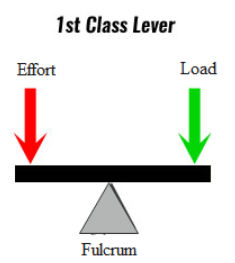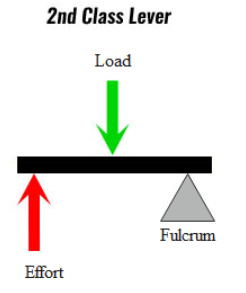
Name three classes of levers and distinguish between them. Give examples of each class of lever.
Answer
568.8k+ views
Hint: A rigid section resting on a pivot, which is used to lift a heavy firmly fixed body with one end when pressure is applied to another end of the pivot is known as a lever. By lifting the body the potential energy is also increased. Potential energy is amplified as it is dependent on the height at which the object is placed from the reference line.
Complete answer:
There are three types of lever. The difference between these classes depends on where the force is applied and where the fulcrum is and the position of the applied load. There are three classes of levers which are termed as
Class I levers
Class II levers
Class III levers
A. Class I levers: In these types of levers, the fulcrum F is in between the input force (effort) and the output force (load).
Example: A Seesaw, a pair of scissors, crowbar.

B. Class II levers: In these types of levers, the load L is in between the input and the fulcrum F. The input (effort) arm is thus always longer than the load arm.
Example: a nutcracker, a bottle opener.

C. Class III levers: In these types of levers, the input (effort) is in between the fulcrum F and the load L and the effort arm is always smaller than the load arm.
Example: Sugar tongs, Forearm that is used for lifting a load.

Note:
The lever works on the principle according to which equilibrium can be established when the sum of the moments of the forces acting in a clockwise direction is made the same as the sum of the moments of the forces acting in a counterclockwise direction. This can be easily done, to overcome a large force at a short distance from the fulcrum by applying a small force at a great distance from the fulcrum.
Complete answer:
There are three types of lever. The difference between these classes depends on where the force is applied and where the fulcrum is and the position of the applied load. There are three classes of levers which are termed as
Class I levers
Class II levers
Class III levers
A. Class I levers: In these types of levers, the fulcrum F is in between the input force (effort) and the output force (load).
Example: A Seesaw, a pair of scissors, crowbar.

B. Class II levers: In these types of levers, the load L is in between the input and the fulcrum F. The input (effort) arm is thus always longer than the load arm.
Example: a nutcracker, a bottle opener.

C. Class III levers: In these types of levers, the input (effort) is in between the fulcrum F and the load L and the effort arm is always smaller than the load arm.
Example: Sugar tongs, Forearm that is used for lifting a load.

Note:
The lever works on the principle according to which equilibrium can be established when the sum of the moments of the forces acting in a clockwise direction is made the same as the sum of the moments of the forces acting in a counterclockwise direction. This can be easily done, to overcome a large force at a short distance from the fulcrum by applying a small force at a great distance from the fulcrum.
Recently Updated Pages
Why are manures considered better than fertilizers class 11 biology CBSE

Find the coordinates of the midpoint of the line segment class 11 maths CBSE

Distinguish between static friction limiting friction class 11 physics CBSE

The Chairman of the constituent Assembly was A Jawaharlal class 11 social science CBSE

The first National Commission on Labour NCL submitted class 11 social science CBSE

Number of all subshell of n + l 7 is A 4 B 5 C 6 D class 11 chemistry CBSE

Trending doubts
What is meant by exothermic and endothermic reactions class 11 chemistry CBSE

10 examples of friction in our daily life

One Metric ton is equal to kg A 10000 B 1000 C 100 class 11 physics CBSE

1 Quintal is equal to a 110 kg b 10 kg c 100kg d 1000 class 11 physics CBSE

Difference Between Prokaryotic Cells and Eukaryotic Cells

What are Quantum numbers Explain the quantum number class 11 chemistry CBSE




